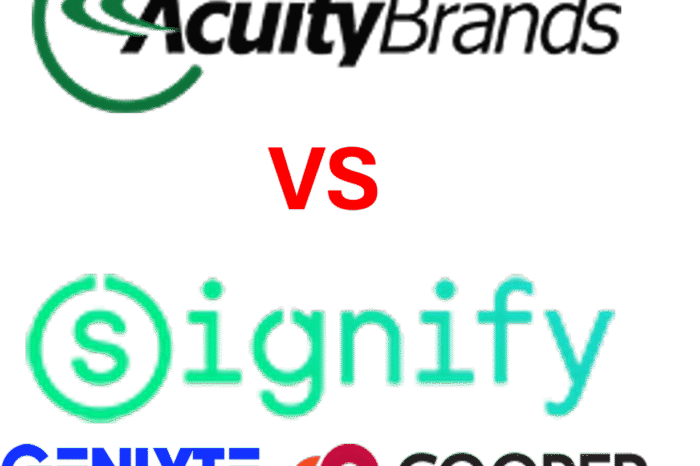Acuity Delivers Another Record But Only 4%
 Last week Acuity shared its fourth quarter / end of year report providing some insight into the lighting market for July through September. From an Acuity viewpoint it was another record quarter and year.
Last week Acuity shared its fourth quarter / end of year report providing some insight into the lighting market for July through September. From an Acuity viewpoint it was another record quarter and year.
From the earnings call:
- Record Q4 and annual … but, and this is of interest, they had “higher expectations” but the market was “more subdued from a growth perspective than most had originally expected as demand remained frat throughout much of the year.” (find this interesting as most distributors we’ve talked with our up significantly in lighting but their sales are impacted, positively, by non-top tier lighting companies. This is the price-driven market. Wonder how Acuity performed based upon a new construction vs renovation growth perspective? It begins to beg the question of the value of “brand” for price-sensitive renovation projects? Perhaps an area where distributors may want to ask their contractors … what is important and when?)
- For Q4 (July-Sept) Acuity was up about 4%, adjusted operating profit was up 13%.
- For full year (they are on a fiscal year), sales were up almost 7% with adjusted operating profit up 7%.
- Their “net vs overall” sales were impacted by 1% due to price with Acuity commenting that “impact of price mix was primarily due to changes in product price, primarily for more basic, lesser-featured, LED luminaires sold in certain channels.” (hopefully they are not referring to electrical distribution, but, the comment speaks to the issue that price is growing factor in the decision making process and probably the competitive environment that is in the market … much overseas produced products and “newer / unknown” companies that are taking lighting business either through distribution or direct. Additionally during this time period, Hubbell Lighting introduced their TradeSelect offering, which is a contractor-oriented “value” line.)
- Suggest that “available market data” suggests shipments of lighting fixtures in the US was flat to slightly done. (Acuity may be referring to NEMA data, however, only manufacturers associated with NEMA, and then, not even all of them, provide self-reported data to NEMA, and the shipment data is to all channels. Bottom line … it’s an incomplete view of the market … only selected manufacturers.)
- LED is now 2/3rds of net sales (So, the lexicon should change. There shouldn’t be a need to say “LED lighting”, it’s now just “lighting.” The LED should be inferred and other types need to be specifically mentioned, when appropriate.)
- Mention about their IoT software platform and tiered solution strategy, which is gaining traction as sales in Tier 3 which is their “holistic integrated solutions” were up almost 30% and represent about 15% of sales. And they mentioned their Atrius platform is growing. (From recently doing planning with a number of distributors, many are familiar with IoT, sense it will be important but when asked specifically about Acuity’s tiered solutions and how “they” could utilize them within their 2018 initiatives, or longer-term, none knew. When asked if they could learn more, they weren’t able to. Don’t know if this is a sales management awareness or training issue, a marketing issue, an issue of which channel(s) that Acuity wants to support for is initiative issue or a strategic issue for Acuity? Perhaps they want select / exclusive distribution in various marketplaces or the concept is still in pilot mode?)
- Atrius has been deployed across almost 90 million square feet, so it’s gaining traction (presumably there is a “customer profile” that is gravitating first to the solution. Would be good to hear how distribution has been involved in some of these projects and/or the 1+ billion square feet of Acuity network lighting systems that are upgradeable to Atrius.)
- Tier 1 and Tier 2 products / solutions are “lesser featured entry level products”. (Which sounds like the “standard” products that distribution sells and defines Acuity. Perhaps they segment distributor sales by percent by tier? Perhaps ask Acuity what is your’s and then discuss what percent you want to be by tier and develop a plan to get there? There could be an opportunity to be a local marketplace leader in some of this functionality. Does Acuity want to help like-minded distributors?)
- Reported that they are hearing that “trades are busy” and that distributor “backlogs are favorable” (We hear the same from our distributor clients.)
- Feel that lighting growth will be “sluggish” for the next few quarters and rebounding in the second half of the year. Reason is recovery from the hurricanes (Houston, Florida). (Begs the question of what are the other reasons impacting the remainder of the country?)
- Leading indicators that Acuity tracks include architecture billing index, vacancy rates, office absorption, lending availability and favorable employment cost. (Distributors may want to track these in their local markets to have a sense of the lighting market growth potential. And then correlate performance vs their total lighting performance, their performance with Acuity and perhaps their overall business performance. Perhaps see if Acuity can provide state-specific (wonder if they do state-level forecasting?)
- 2018 projection … low single-digit growth fueled by second half of the year.
- Expect to grow more than the market
- Expect to continue to improve product mix to “higher” tiers
- Expand product offering
- An analyst asked “about Chinese competition at the low end of the market, and I am wondering what percent of sales would this impact and is lower pricing impacting the stock in flow business?”
- Acuity responded:
- “More and more clear that the folks there and some of these manufacturers are being subsidized.”
- ” But I would say that, overall, when we look at our price mix and I talk to our customer base, they are seeing some impact but I would not say it’s a material impact.”
- “I see that the china.com sort of syndrome is in a very, very small select group of products.”
- Acuity responded:
(Seems like a politically correct, shareholder friendly response to sidestep an analysts call. And since these unfamiliar suppliers are not into the IoT offering, mathematically can be somewhat correct. But it also begs the question of what % of Acuity products, and sales, are manufactured in China (and same for other key lighting manufacturer). Not all the quality is poor and not all customers (especially contractors) are overly concerned with top quality product. Distributors are selling more “unfamiliar lines”, so there must be a reason. As a distributor, look at your lighting sales from 5 years, 3 years and this year. Looking at the % of sales to the top 3-4 lines and then “all other” and also count the number of “all other” lines your company buys from. Check the change in the business.)
- Acuity “feels” the smaller, short cycle project market has slowed a bit but seeing growth in the luminaires + technology market (new construction & major renovation). (Distributors, do you think Acuity is missing business / losing business in the short cycle market or are they not as competitive in this space or is this segment slow?)






















